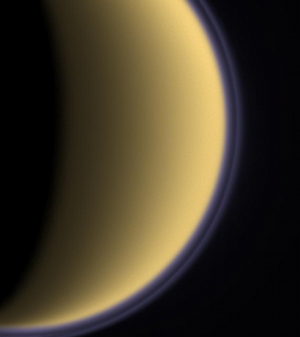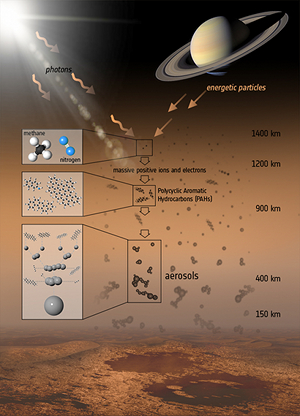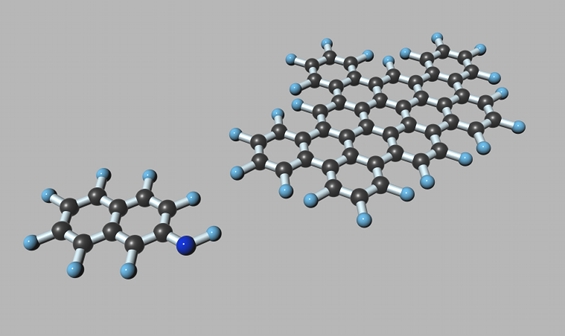Cassini sees precursors to aerosol 'snow' on Titan
5 June 2013
Scientists have confirmed the presence of PAHs - Polycyclic Aromatic Hydrocarbons - in the upper atmosphere of Saturn's largest moon, Titan. The study, based on data from the VIMS instrument on the Cassini orbiter, provides an explanation of the origin of the aerosol particles found in the lowest haze layer that blankets Titan's surface. The PAHs, which form high up in the atmosphere, later grow into larger aggregates that drift down - much like snow flakes - and eventually give rise to aerosols.
 |
|
Cassini image of Titan's haze. |
Of all the bodies in the Solar System, Saturn's largest moon, Titan, has the atmosphere most resembling that of Earth. Like that of our planet, Titan's atmosphere is largely composed of molecular nitrogen (N2); unlike Earth's atmosphere, however, Titan's contains only small traces of oxygen and water. Another molecule, methane (CH4), plays a similar role to that of water in Earth's atmosphere, and makes up about 2 per cent of Titan's atmosphere. Scientists have speculated that the atmosphere of this moon may resemble that of our planet in its early days, before primitive living organisms enriched it with oxygen via photosynthesis.
When sunlight or highly energetic particles from Saturn's magnetosphere hit the layers of Titan's atmosphere above 1000 km, the nitrogen and methane molecules there are broken up. This results in the formation of massive positive ions and electrons, which trigger a chain of chemical reactions, producing a variety of hydrocarbons – a wide range of which have been detected in Titan's atmosphere. These reactions eventually lead to the production of carbon-based aerosols, large aggregates of atoms and molecules that are found in the lower layers of the haze that enshrouds Titan, well below 500 km.
Aerosols in this lower haze have been studied using data from the descent of the Huygens probe, which reached the surface in 2005, but their origin remained unclear. A new study of Titan's upper atmosphere might have solved the puzzle with the detection of Polycyclic Aromatic Hydrocarbons (PAHs), which are large carbon-based molecules that form from the aggregation of smaller hydrocarbons. The detected PAHs appear to be the precursors to aerosols, triggering the first reactions that cause these large, solid particles to sink, like snow flakes, into Titan's lower atmosphere. The study is based on data collected with the Visible and Infrared Mapping Spectrometer (VIMS) on board the Cassini mission.
 |
|
The role of Polycyclic Aromatic Hydrocarbons (PAHs) in the formation of aerosols in Titan's haze. Credit: ESA / ATG medialab |
"We can finally confirm that PAHs play a major role in the production of Titan's lower haze, and that the chemical reactions leading to the formation of the haze start high up in the atmosphere," comments Manuel López-Puertas from the Instituto de Astrofísica de Andalucía (CSIC) in Granada, Spain. López-Puertas is the first author of a paper, published in The Astrophysical Journal, describing these results.
"This finding is surprising: we had long suspected that PAHs and aerosols were linked in Titan's atmosphere, but didn't expect we could prove this with current instruments," he adds.
The team of scientists had been studying the emission from various molecules in Titan's atmosphere when they stumbled upon a peculiar feature in the data. One of the characteristic lines in the spectrum, due to emission by methane, had a slightly anomalous shape, and the scientists suspected it was hiding something.
"We subtracted from the observed spectra the signal caused by methane, which is very strong because this molecule is quite abundant in Titan's atmosphere. And that's when we found out that it was covering up something else," explains co-author Bianca Maria Dinelli from the Istituto di Scienze dell'Atmosfera e del Clima (CNR) in Bologna, Italy. "We found an additional emission feature. But we had no idea what it was," she adds.
Painstaking investigation followed to identify the chemical species responsible for this emission. The additional signal was found only during daytime, so it clearly had something to do with solar irradiation.
"The central wavelength of this signal – about 3.28 microns – is the typical one of the emission from aromatic compounds – hydrocarbon molecules in which the carbon atoms are bound in ring-like structures," explains Dinelli.
The scientists tested whether the unidentified emission could be produced by benzene (C6H6), the simplest aromatic compound consisting of one ring only, which had been earlier detected in Titan's atmosphere. However, the relatively low abundances of benzene are not sufficient to explain the emission that had been observed.
After they ruled benzene out, the scientists tried to reproduce the observed emission with PAHs, which are more complex aromatic molecules containing several rings. And they were successful: the data can be explained as emission by a mixture of many different PAHs, which contain an average of 34 carbon atoms and about 10 rings each.
 |
|
Two of the most likely abundant PAHs found in Titan's atmosphere: C10H8N (left) and C48H22 (right). Credit: ESA / ATG medialab / NASA Ames PAH IR Spectral Database |
"Although less abundant than benzene, PAHs are very efficient in absorbing ultraviolet radiation from the Sun, redistributing the energy within the molecule and finally emitting it at infrared wavelengths," explains co-author Alberto Adriani from the Istituto di Astrofisica e Planetologia Spaziali (INAF) in Rome, Italy. Adriani is part of the Cassini-VIMS co-investigator team based at INAF, Italy, that collected and processed the data.
"It is not only this 'solar pumping', but also the peculiar characteristics of PAHs that cause these molecules to radiate so profusely, after having absorbed ultraviolet photons from the Sun, even in the rarefied environment of Titan's upper atmosphere, where the collisions between molecules are not very frequent," comments López-Puertas.
The PAHs themselves are a product of photoionisation of smaller molecules in the upper atmosphere of Titan – and the first step in a sequence of increasingly larger compounds. Models show how PAHs can coagulate and form large aggregates, which tend to sink, due to their greater weight, into the lower atmospheric layers. The higher densities in Titan's lower atmosphere favour the further growth of these large conglomerates of atoms and molecules, leading to the eventual formation of aerosols.
"The direct detection of PAHs in Titan's atmosphere is an important step in understanding the role of carbon compounds in another body in the Solar System," says Nicolas Altobelli, Cassini-Huygens Project Scientist at ESA. "In the future, we plan to study how these compounds behave with the seasons in the data from Cassini: aerosols in the lower haze are known to undergo seasonal variations, so finding a similar trend in the PAHs would be a further proof of their close connection."
Notes for editors
The study presented here is based on observations performed with the Visible and Infrared Mapping Spectrometer (VIMS) on board the Cassini orbiter of the NASA/ESA/ASI Cassini-Huygens mission. The data were gathered during two of Cassini's flybys of Titan in July and August 2007.
The study is based on data collected and processed by the Cassini-VIMS co-investigator team based at INAF, Italy and on further detailed atmospheric modelling performed by collaborators from the Italian CNR and the Spanish CSIC institutes.
The study focuses on a strong emission feature detected at 3.28 microns in Titan's upper atmosphere during daytime. The emission is produced at altitudes between 600 and 1250 km, and has a peak around 950 km.
The attribution of the emission to Polycyclic Aromatic Hydrocarbons (PAHs) was done using the NASA Ames PAH IR Spectral Database. The emission is caused by a mixture of PAHs containing a number of carbon atoms that ranges from 9 to 96, and an average of 10-11 rings. The two most likely abundant PAHs in this mixture are C48H22 and C10H8N.
Related publications
M. López-Puertas, et al., "Large abundances of Polycyclic Aromatic Hydrocarbons in Titan's upper atmosphere", 2013, Astrophysical Journal. DOI: 10.1088/0004-637X/770/2/132
B.M. Dinelli, et al., "An unidentified emission in Titan's upper atmosphere", 2013, Geophysical Research Letters, Vol. 40, Pag. 1-5. DOI: 10.1002/grl.50332
Contacts
Manuel López-Puertas
Instituto de Astrofísica de Andalucía (CSIC)
Granada, Spain
Email: puertas![]() iaa.es
iaa.es
Phone: +34-958-230507
Bianca Maria Dinelli
Istituto di Scienze dell'Atmosfera e del Clima (CNR)
Bologna, Italy
Email: BM.Dinelli![]() isac.cnr.it
isac.cnr.it
Phone: +39-051-639805
Alberto Adriani
Istituto di Astrofisica e Planetologia Spaziali (INAF)
Rome, Italy
Email: alberto.adriani![]() iaps.inaf.it
iaps.inaf.it
Phone: +39-06-45488365
Nicolas Altobelli
ESA Cassini-Huygens Project Scientist
Directorate of Science and Robotic Exploration
European Space Agency
Email: nicolas.altobelli![]() sciops.esa.int
sciops.esa.int
Tel: +34-918131201



